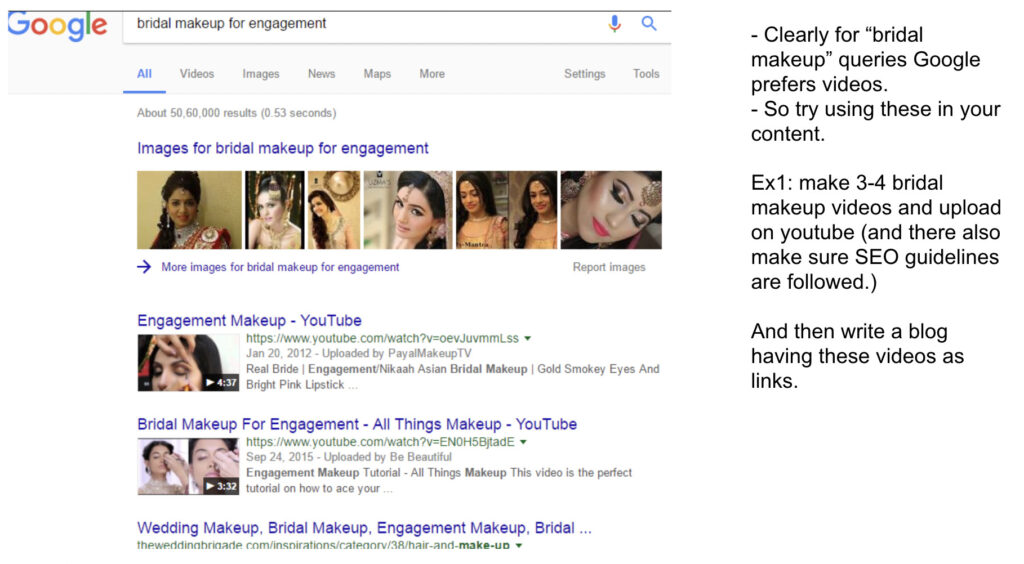Summary: Below is part 1 of a step-by-step approach that can help you rank on the first page of Google. Unfortunately, there is no shortcut to SEO and it requires attention to detail in many areas. In part 1 I detail out the background or research your content strategy needs to have in order to win in SEO.
This blog is inspired by my time at TravelTriangle and how we were successful in the SEO race in the travel industry’s tour package segment. Unlike many other blogs, I focus on actionable items that you can use in your content strategy to win in the SEO race.
PS: The approach or steps presented below are updated until 2018, and from what I have checked, not much has changed and the basics remain the same. SEO encompasses technical maintenance, website organization, and more. In this two-part series, we will only discuss creating a successful SEO content strategy.
You can read the part 2 here.
Why We Focused On SEO?
- I Led growth at TravelTriangle, a travel-focused marketplace for booking tour packages through travel agents. In 2014, most traffic came from paid Google marketing (SEM), which was effective for targeting users with high purchase intent but highly competitive in the travel segment.
- Travel is a search-based category: users research, read, and watch videos before making decisions.
- Data indicated that acquiring users early in the booking process was crucial for building trust.
- With SEM, we targeted lower-funnel users (e.g., searching “book tour package for Kerala”), but they often read multiple blogs on competitor sites before booking. Keyword planner tools and user interviews confirmed this behavior
- It was not cost-effective to target middle-funnel users via SEM.
- To build a sustainable business, we needed to focus on SEO and guide users throughout the research phase.
If you are in a category where users typically conduct extensive research and content can be valuable, please continue reading.
PS: This blog is not meant for total beginners for SEO. I suggest you read SEO101 and then come back here to learn how to implement it.
Step 1: Research
When creating content, there are two common approaches:
- Approach 1: Write the best content first, then optimize for SEO later.
- Approach 2: Research your industry and keywords, identify which ones are valuable and winnable (i.e your content can rank), and use those as the foundation for your content ideas.
Approach 2 is recommended, as it increases the likelihood of making your content discoverable, even if it makes writing slightly more challenging.
To conduct effective research, follow these four steps:
- Competitor research: If you are new to a field (like I was) then analyzing what your competitors are doing successfully can give you a firm ground to stand on.
- Category research: Understand your business and target audience.
- Keyword research: Identify relevant and valuable keywords (complete steps 1 and 2 first to ensure a data-driven approach).
- Content form research: Determine the most effective formats for presenting your content (e.g., articles, videos, infographics).
Competitor Research
If you are new to a field then analyzing what your competitors are doing successfully can help you get started.
- Analyzing your main competitors can help you understand their priorities, user funnels, and effective strategies in your sector.
- Instead of focusing on the most successful or longest-standing competitors, look at those who are winning in SEO and have a similar domain age or slightly older than you.
- Use basic google search to see who ranks (on 1st and 2nd page) for relevant keywors and/or use similarweb to see traffic details.
- Study their website structure, paying attention to details such as:
- Elements above the fold on the homepage or landing page.
- Main navigation links and site hierarchy.
- Conversion funnel stages
- Understanding the user journey will help you identify various stages of the conversion funnel, thereby increasing your knowledge of the category.
- Next, examine their content strategy (this can also be done later as you become more familiar with the domain):
By conducting thorough competitor research, you can identify and implement effective strategies to improve your own website’s SEO performance.
Category Research
- If you have completed Competitor Research or used logical reasoning, you should have a rough idea of the user journey.
- To understand your users better, consider the following aspects at each stage of the journey or funnel:
- Who is the user?
- What are their thoughts or concerns at this stage?
- What problem do they want solved?
- What could be their next step?
- Gaining a deep understanding of your business and users will help you identify the language and semantics they use—incorporate these into your content. It’s very important to understand that.
- Speak to your existing users to gain insights; if you don’t have users yet, examine competitor reviews or watch videos to understand the language they use.
By thoroughly researching your category, you can create content that resonates with your audience using language they use and effectively addresses their needs. This approach will not only make your content more relevant and engaging but also increase the likelihood of users moving further along the conversion funnel.
Keyword Research
Before using keyword planner or similar tools, utilize your logic and understanding (as acquired above) to identify what people are searching for. Observe patterns and create a universe of such patterns.
This way you will cover breadth and depth of these topics and thus minimise the risk of starting with wrong topics/keywords. Further when you have done this you would have the user funnel in front of you being represented by keywords 🙂


- Depending on the funnel you want to attack, now use google planner or other tools to extract search volumes and toughness.
- Keyword planner may not give you data for a lot of queries.
- To clarify, it’s important to examine your funnel and determine if this pattern is significant for your funnel. If you’re aggregating this pattern across categories, then it’s something you can pursue. For example – maybe bridal makeup for round face gets less searches but all such keywords combined (bridal makeup for face-type) can be decent number of searches and thus worth pursuing.
- Identify keyword queries which implicitly or explicitly ask a question — google loves this.
- You should produce a list of keywords. Identify which ones you want to target.
Keyword Selection
- Avoid selecting extremely competitive keywords initially, as the success rate may be low (e.g., 1/10).
- Allow a minimum of 60 days for ranking on a keyword; you might rank sooner, but discipline is crucial.
- Plan your content schedule based on seasonality or trends; for example, if the wedding season starts in December and brides-to-be search for bridal makeup from mid-October, publish your content by mid-August.
- Initially, focus more on long-tail keywords (which have fewer searches) in your content plan, maintaining a 70-30 split between long-tail and short-tail keywords.
- As you begin ranking for long-tail keywords, leverage that success to target short-tail keywords by interlinking related content and passing link juice.
- Google values comprehensive coverage of a topic, so consider creating in-depth content on a specific subject; this approach was followed by TravelTriangle to great success.
Content Form Understanding
- Remember that content is not just text; there are various options and forms to consider.
- Identify different content forms, each with its own advantages (e.g., text, images, videos, infographics).
- Analyze what type of content Google predominantly displays for your chosen keyword (e.g., SERP listings, answer boxes, videos, maps); it’s not effective to create blogs if they don’t rank for your keyword. Google tells you what users want, observe it carefully. (See image below)
- Examine the content type, language, and form used by top-ranking players in SERP results; aim to offer a better experience than your competitors.
- Don’t be afraid to experiment with new content forms, but be patient as immediate results may not be guaranteed.
- For advanced users, refer this image. It’s very helpful.
The table provides an overview of different content forms, their purposes, and the results I observed.
| Blog Type | Purpose | Best Approach |
|---|---|---|
| SEO – Long form, listicles | Organic Traffic, Link Building | Lists should be >= your competitor, long form >= 2000 words works well, have multi-page pages (improves pages/session). |
| Photoblogs | Easy Traffic, Low Effort | Works for some, but personally failed to rank. |
| Video Blog | Increase Time on Site, SEO Optimized | Note: video increases site metrics/engagement, consider a dual content strategy with YouTube + text. |
| Infographic | Social Traffic, Educate, Links | Didn’t have much success personally, but works well for others. |
| Quiz | Interaction, Time on Site, Social | Useful for increasing site metrics which helps with overall SEO. |
| Interactive Blogs | Interaction, Time on Site, SEO, Link Generation | Effective for increasing site metrics |
By carefully considering content forms and analyzing Google’s preferences for specific keywords, you can create a variety of engaging and effective content types that are more likely to rank higher in search results.

In Part 1 of this blog series, we provided useful information on research required for a successful content strategy, including competitor analysis, category research, keyword selection, and content form exploration. Part 2 will cover producing influential content that engages your audience and helps you excel in SEO.
Please feel free to leave comments below or reach out to me here to discuss further.







